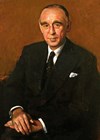A recent article in Eye News by Blaikie & King highlighted the extraordinary contribution made to the profession of ophthalmology by Sir William Stewart Duke-Elder. The author felt it appropriate to take a further in-depth look at the remarkable career of the Scots- born founder of modern ophthalmology [1].
The picturesque Scottish village of Tealing nestles at the foot of the prominent Sidlaw Hills almost 10 miles from the industrious city of Dundee. Notably included in the area is an iron age ‘earth house’ and a stone-built dovecot. However, the village will rightly be most remembered as the childhood hometown of Sir William Stewart Duke-Elder, the most prominent and influential ophthalmologist of the twentieth century, not only in Great Britain but throughout the world. In a unique and remarkable medical career, Duke-Elder was to become the founder of contemporary ophthalmology and oculist to three British monarchs and a UK prime minister (Figure 1).

Figure 1: Sir William Stewart Duke-Elder (1898–1978), by Ruskin Spear in (1956).
Credit: Institute of Ophthalmology, United Kingdom.
Early years
Born on 22 April 1898, in Dundee, Duke-Elder was the middle son of the Reverend Neil Stewart Elder, a minister of the United Free Church of Scotland, and Isabelle, née Duke, who was herself the daughter of a minister of the United Free Church [2]. Throughout his life, Duke-Elder was referred to by family and acquaintances by his middle name of Stewart.
This learned and literary background was to instil in the young Duke-Elder the characteristics that were to be so useful to him in later life, most notably; erudition, copious energy and an astonishing capacity for academic work. No doubt the rural idyll of Tealing was a wonderfully adventurous area to grow up in.
Early education was amply provided by Morgan Academy in Dundee, to which Duke-Elder and his brothers were driven each day in a pony and trap. Studies at home in the evening were conducted under the flickering light of candles [3]. Duke-Elder was to benefit from the Scottish tradition of a broad-based education and academic success was apparent from an early stage when he was frequently top of his class. In 1914–1915, Duke-Elder graduated from Morgan Academy with the Gold Dux Medal along with further gold medals for the subjects of English, Greek, Biology and Religious Knowledge [2].
St Andrews University
The Reverend Stewart Elder had hoped that his second son would follow him and pursue a calling to join the ministry, however in a display of independence the young Duke-Elder entered the bursary competition for Scotland’s oldest university: St Andrews [4]. He was to top the list of entrants and subsequently was awarded the university’s first foundation scholarship with a bursary of £50 a year for the next four years [2]. Intending to join the medical profession, Duke-Elder initially enrolled for an arts and science degree. His studies bore fruit when, in 1919, he graduated with first class honours MA in Natural Sciences along with a BSc with special distinction in physiology, having also served as a demonstrator in physiology during his final year [2].
In order to continue his medical studies, Duke-Elder joined the University College, Dundee, undertaking clinical duties at the Royal Infirmaries of Dundee and Edinburgh (the latter institutions were all affiliated to St Andrews University School of Medicine). Once more his skills were put to good use as a demonstrator, this time of anatomy, between 1920–1921. In an early example of his aptitude in leadership and ability to rise to the top of an organisation, Duke-Elder became President of the St Andrews University Students’ Representative Council and subsequently President of the Students Union from 1921 to 1922. During his tenure in office, Duke-Elder commented that one of the responsibilities of universities was to produce men and women who were “leaders of thought and leaders of action” [3]. During what little spare time was available, he played cricket, rugby, football, golf and took part in the then relatively new activity of rough track motor-cycle racing.
Duke-Elder graduated from the University of St Andrews School of Medicine in 1923 with an Bachelor of Medicine (MB ChB). It was the first step in an extraordinary medical career.
First steps in ophthalmology
It was his interest in physiology and especially in the workings of the eye that drew Duke-Elder to ophthalmology as his chosen medical specialisation. Early in his career, Duke-Elder’s abilities were to come to the attention of Sir John Parsons FRS (1863–1957). The latter was a leading ophthalmic surgeon at University College Hospital, London and also at Moorfields Eye Hospital. Sir John had a worldwide reputation for pioneering research into ocular physiology and presided over well-equipped research facilities, to which Duke-Elder received an invitation to join [2].
Thus, in 1924, Duke-Elder left Scotland for London and began research work at University College under the particular tutelage of renowned physiologist Professor Ernest Starling (1866–1927). En route, Duke-Elder gained valuable medical experience during a brief period as a locum general practitioner and, in addition to his research post, went on to become a clinical assistant in the eye department of St George’s Hospital, London [1]. Furthermore, during this transition year, Duke-Elder passed the final examination of the Royal College of Surgeons of England (FRCS) [4].
Establishing what was to become the hallmark of all his future undertakings, Duke-Elder’s research activities were to rapidly produce important results along with official recognition; and in 1925, his dissertation on ‘Reaction of the eye to changes in osmotic pressure of the blood’ was to earn him the award of MD along with a gold medal from his former university of St Andrews [5]. Later in the same year, London University awarded him a PhD [5].
In 1926, Duke-Elder was appointed assistant ophthalmic surgeon at St George’s Hospital and a year later he was further honoured by St Andrews University, who awarded him a DSc in recognition of his thesis on ‘The nature of the intraocular fluids and the pressure equilibrium in the eye’ [5]. The study of intraocular pressure and its associated disease complex of glaucoma was to be of great significance to Duke-Elder in later years.
Ophthalmology publications
It was as a prolific writer and educator that Duke-Elder was to find particular fulfilment and distinction, taking his initial steps in the print medium in 1927, when he was asked to edit the first edition of Recent Advances in Ophthalmology. Duke-Elder’s clear and lucid writing style rapidly found favour in ophthalmological and academic circles and in 1928 he wrote the excellent single volume textbook, Practice of Refraction [2]. The latter was one of the first textbooks to cover the essential practical aspects of refraction and the correction of its associated optical errors, and the book’s successive updated editions were to remain essential reading for all would-be refractionists.
The year 1928 was to be a particularly happy one for Duke-Elder. Early in the year, he was appointed ‘full ophthalmic surgeon and permanent consultant’ at Moorfields Eye Hospital. It was whilst working in this capacity that Duke-Elder met fellow ophthalmology student Phyllis Mary Edgar MB, BS. Theirs was to be a rapid romance and they were married within a few months. Throughout their long years of marriage, Phyllis provided essential love, support and advice to Duke-Elder and even aided in the research for many of his early academic papers. The couple became the most generous of hosts to the never-ending dignitaries who visited their home in Harley Street, London, never more so than when Duke-Elder was President of the Ophthalmological Society of the UK between 1965 and 1966 [2].
Phyllis accompanied her husband when, in 1930, he was invited to make his first visit to America in order to undertake clinical work and present the Howe lecture at Harvard University. Such was the high esteem in which he was held that Duke-Elder was subsequently presented with the Howe medal, an honour awarded (since 1926) for original research and distinguished service to ophthalmology [4].
As a result of his prodigious writing and research activities, Duke-Elder had, within a remarkably short amount of time, become a renowned figure within the ophthalmology profession. However, events were soon to bring him to the attention of the general public.
Glaucoma treatment of Ramsay Macdonald
In January 1932, the Royal Physician, Lord Thomas Horder, referred his patient, Ramsay Macdonald, the serving British Prime Minister, for an ophthalmic examination conducted by Duke-Elder. A diagnosis of glaucoma was made (aptly described by the press as ‘hardening of the eyeballs’). Furthermore, Duke-Elder advised Macdonald that surgery was urgently required in order to relieve the ocular pressures. Thus, having initially sought the further advice of eminent ophthalmology colleagues, Sir John Parsons and Sir William Lister, Duke-Elder performed a delicate operation initially on Macdonald’s left eye and then on his right eye. Further examination was to reveal that the operations had been successful.
Ramsay Macdonald was particularly pleased to have been treated by a fellow Scotsman, and in 1933, the grateful Prime Minister bestowed upon his eye surgeon the honour of a knighthood [3].
Textbook of ophthalmology
It was as a writer, editor and educator that Duke-Elder was to make his greatest contribution to ophthalmology and thereby benefit those with eye diseases. He had become aware that there was no standard reference textbook for those studying ophthalmology. In an attempt to rectify this anomaly, he began the arduous task of writing his seventh volume, Textbook of Ophthalmology, produced between 1932 and 1954 [2]. Published by Henry-Kimpton, it was a landmark publication and immediately became the authoritative textbook on its subject, further establishing Duke-Elder’s reputation to an appreciative worldwide readership of practising ophthalmologists and students.
Every word in the texts had been hand-written by Duke-Elder and in recognition of his achievement he was awarded the Fothergillian Prize of the Medical Society of London for the best contribution to medical literature of that decade [2]. Yet the volumes making up Textbook of Ophthalmology were to be only a prelude to even greater literary academic achievements to come.
By now Duke-Elder had become the most respected and authoritative ophthalmologist in the UK. Further recognition of his status was to occur in 1936 when he achieved the distinction of being appointed Surgeon Oculist to King Edward VIII and subsequently to King George VI and finally to Queen Elizabeth II. Duke-Elder was to retire from the post in 1965, having occupied it for a remarkable 29 years; longer than anyone before or since [4]. In recognition of his services to the monarch and the royal family Duke-Elder went on to become a Knight Commander of the Royal Victorian Order (KCVO) in 1946 and subsequently a Knight Grand Cross of the Royal Victorian Order (GCVO) in 1958.
Second World War service
International storm clouds were gathering and at the onset of the Second World War in 1940, Duke-Elder joined the Royal Army Medical Core. Initially holding the rank of Lieutenant, subsequently being promoted to Colonel and eventually becoming appointed consultant ophthalmic surgeon to the army with the rank of Brigadier, he was to serve with distinction throughout the conflict [4]. The administrative experience Duke-Elder gained in the latter post was to be of particular use to him in his post-war endeavours. On a practical note, Duke-Elder ensured that those military personnel for whom optical correction was essential were provided with two pairs of basic spectacles.
The Faculty of Ophthalmologists
As early as 1937, Duke-Elder was giving increasing consideration as to how best to advance the academic, scientific and clinical standards of ophthalmology.
A major step towards achieving these aims took place in 1945 when Duke-Elder supervised the amalgamation of the Council of British Ophthalmology and the Association of British Ophthalmologists to create the Faculty of Ophthalmologists. This was to be the professional body for ophthalmologists with an important role to play in defining good practice, supporting research and innovation, conducting examinations and informing public opinion. The Faculty had its headquarters in the Royal College of Surgeons of England [3]. Duke-Elder was duly elected its first President and he diligently arranged for the Faculty to be represented on the council of the Royal College of Surgeons of England and for the latter organisation to offer, for the first time, a distinct examination for FRCS in ophthalmology [3]. Following further amalgamations, in 1988, the Faculty became the Royal College of Ophthalmologists which continues to work for the benefit of patients and the profession of ophthalmology.
The Institute of Ophthalmology
In the immediate aftermath of the Second World War, the prospect of the creation of the National Health Service in 1948 concentrated Duke-Elder’s attention on how best to raise the standard of British ophthalmology. What was needed was an institute where dedicated teaching and research could be carried out. Working in conjunction with pioneering ophthalmology colleagues, Sir John Herbert Parsons and Professor Ida Mann, Duke-Elder proposed that three of the major eye hospitals in London should be amalgamated thereby facilitating the establishment of the Institute of Ophthalmology in 1947 [2]. Not only was Duke-Elder instrumental in the setting up of the new Institute (now part of the University College London), he was the obvious, possibly the only, ophthalmologist suitably qualified to become its first Director of Research, a position he held for 17 years. Throughout this time, he gave invaluable assistance in the training of young ophthalmologists, especially in the fundamental science of their speciality. In recognition of his work at the Institute, Duke-Elder was awarded in 1960, Fellowship of the Royal Society, a distinction not frequently given to members of the medical profession involved in clinical work [2]. Upon his retirement from the Institute in 1965, Duke-Elder was appointed its life President and Emeritus Director of Research.
The System of Ophthalmology
It was as a relentlessly prolific writer and editor that Duke-Elder was to make his greatest contributions to ophthalmology and medical literature. A bibliophile at heart, he was at his happiest undertaking long hours of studious writing. By the mid-1950s, Duke-Elder had single-handedly completed seven volumes of his seminal Textbook of Ophthalmology. However, he realised that already it required revising and bringing up to date. Not content with publishing a further edition, Duke-Elder endeavoured to use his ‘Textbook’ as a framework for a much wider collection of texts offering the most comprehensive account on the subject of ophthalmology ever written. Thus between 1958 and 1976 he oversaw the creation of 15 volumes of the System of Ophthalmology [4]. Once again published by Henry-Kimpton, each volume had over 1000 pages and benefitted from at least 800 illustrations. Duke-Elder became not only ‘writer in chief’ but commissioning editor as he enlisted contributions to each chapter from many of his eminent colleagues working in the Institute of Ophthalmology.
Producing 15 comprehensive volumes was a monumental task which would have been prohibitively exhausting to most people, however, fortuitously Duke-Elder seemed to require remarkably few hours of sleep and was blessed with extraordinary powers of mental concentration. Not content with creating so many landmarks in ophthalmic literature, Duke-Elder was also for many years Senior Editor of the British Journal of Ophthalmology and of Ophthalmic Literature [2].

Figure 2: The Investiture 1961 for the St John of Jerusalem. Held within,
and published with permission of, the Institute of Ophthalmology Archive.
Hospitaller of the Order of St John
Duke-Elder’s influence on ophthalmology was never to be a parochial force and the benefit of his work was felt in many parts of the world. Between 1950 and 1962 he was President of the International Council of Ophthalmology and he chaired the successful XVI International Ophthalmological Congress held in London [4]. However, Duke-Elder was to prove particularly effective when in 1954, he was invited to take up the position of ‘Hospitaller of the Order of St John’. His main responsibility was the organisation and running of the St John Ophthalmic Hospital, at that time based in somewhat ramshackle buildings in the old city of Jerusalem. Between the years of 1954 and 1968, Duke-Elder oversaw the construction of a new and modern facility, staffed with personnel that he had trained, and with the hospital undertaking research into the causes and treatment of the highly prevalent and sight-threatening disease of trachoma [2]. In recognition of his invaluable aid, Duke-Elder was awarded the Grand Cross of the Order of St John in 1960.
Final years
In 1965, Duke-Elder officially retired from the practice of ophthalmology, although his erudite opinion was constantly sought after by enquiring colleagues. In his later years he was to suffer from emphysema and its associated breathing difficulties. And on 27 March 1978, aged 80, Duke-Elder passed away at his home at St Johns Wood in London, survived by his wife Phyllis.
Sir William Stewart Duke-elder was assuredly the most prominent and respected figure in the post-war practice of ophthalmology not only in the UK but also worldwide. His boundless energy, relentless pursuit of knowledge and compassion for those suffering from ocular pathologies permit him to take his rightful place as the founder of modern ophthalmology.
References
1. Blaikie A, King A. 100 Years since Sir William Duke-Elder graduated from the University of St Andrews. Eye News 2024;30(5):21–1.
2. Sir William Stewart Duke-Elder. Royal College of Physicians.
https://history.rcplondon.ac.uk/inspiring-
physicians/sir-william-stewar
t-duk-eelder#:~:text=Duke%2DElder%20was%20the%
20first,he%20succeeded%20Lord%20Webb%2DJohnson
3. Sen M, Honavar SG. Sir Stewart Duke-Elder: Of a Prime Minister, Three Monarchs, and a Knight. Ind J Ophthalmol 2022;70(2):357–8.
4. Sir Stewart Duke-Elder, G.C.V.O., F.R.S. BJO 1966;50:113–8.
5. Stewart Duke-Elder. Wikipedia.
https://en.wikipedia.org/wiki/Stewart_Duke-Elder
[All links last accessed December 2024]
Declaration of competing interests: None declared.
Author’s note:
The author gratefully acknowledges the assistance given to him in preparing this article by Andrew Blaikie, Honorary Associate Professor, International Centre for Eye Health LSHTM Ophthalmology. Consultant and Senior lecturer, NHS Fife and the University of St. Andrews, School of Medicine, UK.
And also Richard Keeler, Honorary Curator of the Royal College of Ophthalmologists (RCOphth) Museum in London, and Honorary Archivist for the Moorfields (Alumni) Association, for his assistance in sourcing the images of the portraits of Sir Stewart Duke-Elder.










